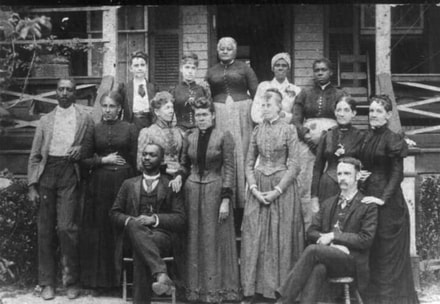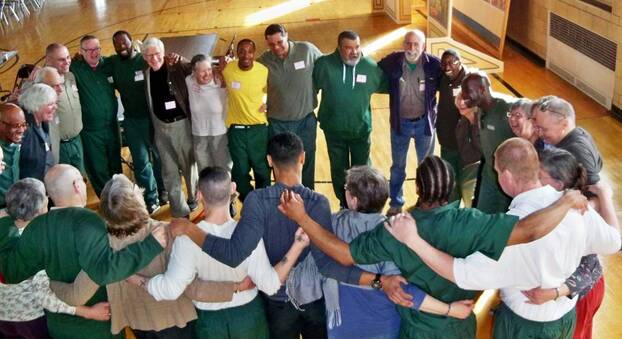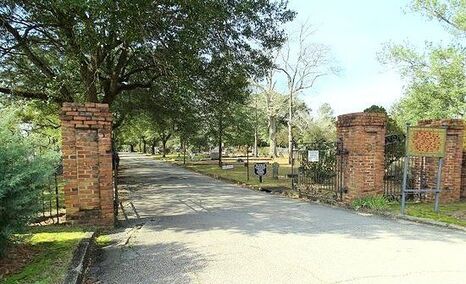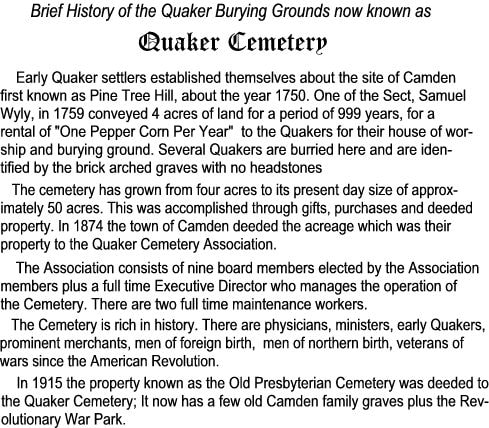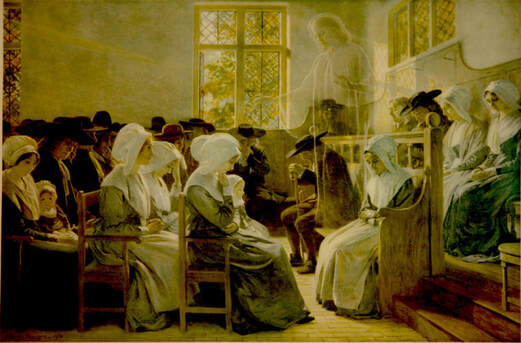
For information on the history of Quakers in South Carolina (from the South Carolina Encyclopedia), click on: Quakers in South Carolina
An addition from Wilhemina Branson, a descendant of South Carolina Friends: “A Quaker from the north, Zachariah Dix, traveled to Bush River to labor with Friends there to give up their slaves and move north. It is the largest migration by a group of people who migrated because of concern for other people besides themselves. Almost the entire Meeting of Bush River migrated to Waynesville, Ohio in 1803, beginning the settlement of Quakers in Waynesville and surrounding territory.”
The Penn Center
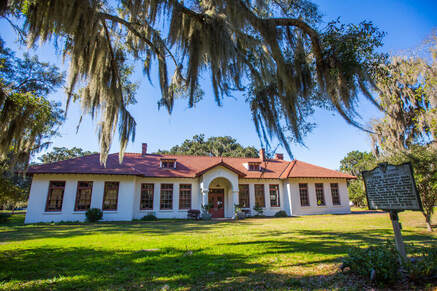
The Penn Center, formerly the Penn School, was founded by Quaker abolitionists and Unitarians in 1862 to educate formerly enslaved people.
The Schofield SchoolThe Schofield School was founded in 1865 by Martha Schofield, a Quaker from Pennsylvania, to provide schooling for formerly enslaved people. |
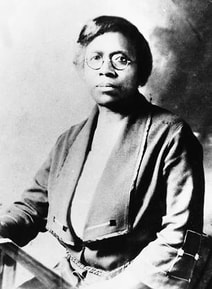
Dr. Matilda Evans
Matilda Arabella Evans, who graduated from the Woman's Medical College of Pennsylvania (WMCP) in 1897, was the first African American woman licensed to practice medicine in South Carolina. Evans's survey of black school children's health in Columbia, South Carolina, served as the basis for a permanent examination program within the South Carolina public school system. She also founded the Columbia Clinic Association, which provided health services and health education to families. She extended the program when she established the Negro Health Association of South Carolina, to educate families throughout the state on proper health care procedures.
Matilda Arabella Evans was born in 1872 to Anderson and Harriet Evans of Aiken, South Carolina, where she attended the Schofield Industrial School. Encouraged by Martha Schofield, the school's founder, Evans enrolled in Oberlin College in Ohio, attended on scholarship for almost four years, and left before graduating, in 1891, to pursue a medical career.
After teaching at the Haines Institute in Augusta, Georgia and at the Schofield School, Evans enrolled at the Woman's Medical College of Pennsylvania in 1893. She received her M.D. in 1897 and returned to Columbia, South Carolina, where she established a successful practice. As the first African American woman licensed to practice in South Carolina, she treated both white and black patients, and was in great demand. She practiced obstetrics, gynecology, and surgery, and cared for patients in her own home until she established the Taylor Lane Hospital (the first black hospital in the city of Columbia) in 1901. By 1907 Dr. Evans was able to write to Alfred Jones, Bursar at Woman's Medical College of Pennsylvania, "I have done well, and have a very large practice among all classes of people... I have had unlimited success... Since I have returned to my native state, others have been inspired and have gone to our beloved college to take degrees." She was writing on behalf of a promising young African American woman who wanted to attend WMCP but was in need of scholarship assistance.
Evans ran her own farm and founded a weekly newspaper, The Negro Health Journal of South Carolina, and offered a program of recreational activities for underprivileged boys. Dr. Evans was elected president of the Palmetto State Medical Society and vice president of the National Medical Association, and in World War I was appointed to the Volunteer Medical Service Corps.
source: https://cfmedicine.nlm.nih.gov/physicians/biography_107.html
Matilda Arabella Evans, who graduated from the Woman's Medical College of Pennsylvania (WMCP) in 1897, was the first African American woman licensed to practice medicine in South Carolina. Evans's survey of black school children's health in Columbia, South Carolina, served as the basis for a permanent examination program within the South Carolina public school system. She also founded the Columbia Clinic Association, which provided health services and health education to families. She extended the program when she established the Negro Health Association of South Carolina, to educate families throughout the state on proper health care procedures.
Matilda Arabella Evans was born in 1872 to Anderson and Harriet Evans of Aiken, South Carolina, where she attended the Schofield Industrial School. Encouraged by Martha Schofield, the school's founder, Evans enrolled in Oberlin College in Ohio, attended on scholarship for almost four years, and left before graduating, in 1891, to pursue a medical career.
After teaching at the Haines Institute in Augusta, Georgia and at the Schofield School, Evans enrolled at the Woman's Medical College of Pennsylvania in 1893. She received her M.D. in 1897 and returned to Columbia, South Carolina, where she established a successful practice. As the first African American woman licensed to practice in South Carolina, she treated both white and black patients, and was in great demand. She practiced obstetrics, gynecology, and surgery, and cared for patients in her own home until she established the Taylor Lane Hospital (the first black hospital in the city of Columbia) in 1901. By 1907 Dr. Evans was able to write to Alfred Jones, Bursar at Woman's Medical College of Pennsylvania, "I have done well, and have a very large practice among all classes of people... I have had unlimited success... Since I have returned to my native state, others have been inspired and have gone to our beloved college to take degrees." She was writing on behalf of a promising young African American woman who wanted to attend WMCP but was in need of scholarship assistance.
Evans ran her own farm and founded a weekly newspaper, The Negro Health Journal of South Carolina, and offered a program of recreational activities for underprivileged boys. Dr. Evans was elected president of the Palmetto State Medical Society and vice president of the National Medical Association, and in World War I was appointed to the Volunteer Medical Service Corps.
source: https://cfmedicine.nlm.nih.gov/physicians/biography_107.html
Laing High School
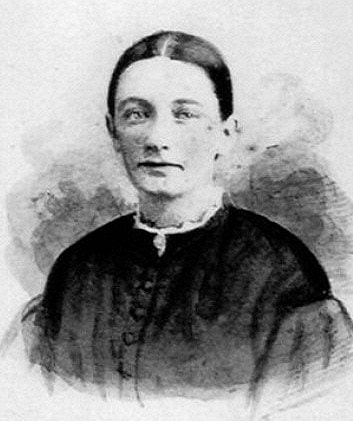
Laing High School was founded in 1866 by Cornelia Hancock, a Quaker from New Jersey, to provide schooling for formerly enslaved people.
From Diane Rowley, currently a member of Atlanta Friends Meeting: “Laing School was the one my husband Bill Jenkins attended after it became part of the public school system. His grandmother and mother matriculated there when it was still under the care of Quakers. Bill recalled that the first book he enjoyed was an old Quaker reader that his grandmother had. In the early years of his career Bill was one of the people who tried to end the Tuskegee Study of Syphilis in the Negro Male. Later when he was a senior epidemiologist he became director of the Tuskegee Benefits Program office, the office at CDC that provided benefits and services to the men and he launched a work group that secured a Presidential apology from Bill Clinton for the study.”
From Diane Rowley, currently a member of Atlanta Friends Meeting: “Laing School was the one my husband Bill Jenkins attended after it became part of the public school system. His grandmother and mother matriculated there when it was still under the care of Quakers. Bill recalled that the first book he enjoyed was an old Quaker reader that his grandmother had. In the early years of his career Bill was one of the people who tried to end the Tuskegee Study of Syphilis in the Negro Male. Later when he was a senior epidemiologist he became director of the Tuskegee Benefits Program office, the office at CDC that provided benefits and services to the men and he launched a work group that secured a Presidential apology from Bill Clinton for the study.”
Alternatives to Violence Project Program
Columbia Friends Meeting began an Alternatives to Violence program in 2015. Since then, they have conducted workshops at Estill prison, the Department of Juvenile Justice Bush River, and Trenton State CI. They have been asked to do programs at Edgefield FCI, Ridgeland, Camille and Manning. Unfortunately, the COVID virus has stopped the trainings for the time being. For information on how to take part in this program, contact Lynn Newsom at [email protected]. See also the "News" tab.
The Grimke SistersThe Grimke Sisters, from Charleston, SC, were advocates for the abolition of slavery and women’s rights. |
Bush River Cemetery
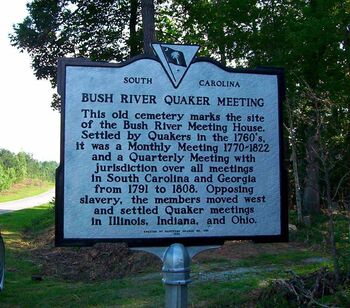
The graveyard is the final resting place of hundreds of the early settlers of Bush River, who originally came from Quaker communities in Pennsylvania, New Jersey, Maryland and North Carolina. When the meeting was laid down, in 1822, most of the Friends from Bush River had already moved to Ohio, Indiana, Tennessee and Alabama. Whether impacted by the hostilities of the Revolutionary war, or displaced due to the slavery, the remnants of the Quaker community left the community or assimilated into other area churches.
The five-acre cemetery, located at 1828-3346 State Road S-36-60 (Dennis Dairy Road), Newberry, SC 29108 is deeded to North Carolina Yearly Meeting of Friends. The Bush River descendants group, energized by Judith F. Russell, has followed up on cemetery care. Columbia Friends Meeting scheduled clean-up outings for several years prior to that. Downed trees from storms and poison ivy had begun to take over. Regular landscaping maintenance was organized by the Bush River descendants group. “Reunions” were held and the now eleventh printing of The Historic Bush River Quaker Cemetery is available for purchase.
The Bush River Descendants group has created rich genealogical resources, which are available
at http://bushriverquakers.blogspot.com and on Facebook at http://www.facebook.com/groups/849196008520904/?ref=bookmarks
To order a copy of the Cemetery book, with history and maps, write to [email protected], at 1151 Fairway Gardens NE, Brookhaven, GA 30319. Donations for cemetery clean up and maintenance can also be sent to this address with checks written to Quaker Cemetery Clean Up Fund.
Further information is available at http://archiver.rootsweb.com/th/[email protected]
As one of the last remaining preserved historical locations of Quakers in South Carolina, Bush River Cemetery has special meaning for Palmetto Friends Gathering.
Submitted by: Grace Gifford
Eighth Month, 7th, 2020
The five-acre cemetery, located at 1828-3346 State Road S-36-60 (Dennis Dairy Road), Newberry, SC 29108 is deeded to North Carolina Yearly Meeting of Friends. The Bush River descendants group, energized by Judith F. Russell, has followed up on cemetery care. Columbia Friends Meeting scheduled clean-up outings for several years prior to that. Downed trees from storms and poison ivy had begun to take over. Regular landscaping maintenance was organized by the Bush River descendants group. “Reunions” were held and the now eleventh printing of The Historic Bush River Quaker Cemetery is available for purchase.
The Bush River Descendants group has created rich genealogical resources, which are available
at http://bushriverquakers.blogspot.com and on Facebook at http://www.facebook.com/groups/849196008520904/?ref=bookmarks
To order a copy of the Cemetery book, with history and maps, write to [email protected], at 1151 Fairway Gardens NE, Brookhaven, GA 30319. Donations for cemetery clean up and maintenance can also be sent to this address with checks written to Quaker Cemetery Clean Up Fund.
Further information is available at http://archiver.rootsweb.com/th/[email protected]
As one of the last remaining preserved historical locations of Quakers in South Carolina, Bush River Cemetery has special meaning for Palmetto Friends Gathering.
Submitted by: Grace Gifford
Eighth Month, 7th, 2020
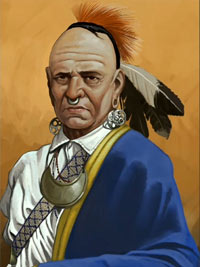
The Indian Chief "King Hagler" was a great friend to the Friends, and tipped them off about an approaching war party from another tribe so they could escape. King Hagler was admitted to the South Carolina Hall of Fame, which is a series of portraits in the Myrtle Beach Convention Center. There are several cemeteries there, and people at the Camden archives (museum with King Hagler's wind vane at the top) can give information.
Quakers followed the "fall line"- the watersheds, as people traveled by canoe, raft etc. After leaving Charleston because it was so dangerous with the meeting house repeatedly burned, Quakers resettled up river until they were finally run out of the state by the slavery culture.
Quakers followed the "fall line"- the watersheds, as people traveled by canoe, raft etc. After leaving Charleston because it was so dangerous with the meeting house repeatedly burned, Quakers resettled up river until they were finally run out of the state by the slavery culture.
Early Photographs of Palmetto Friends Gathering
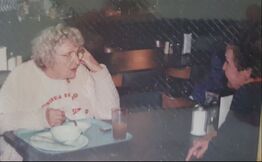
Helen White at first the first Palmetto Friends Gathering on Martin Luther King Day in 1990. Helen and her husband Edwin lived in Colombia, SA, for some years when they taught at a Mennonite School located out from Bogotá.
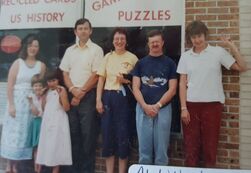
Horry Friends Meeting, circa 1991, at the Surfside Beach shop
of a then-attender.
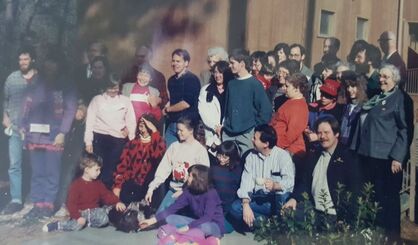
An early 1990s Palmetto Friends Gathering at the Lexington, SC, YMCA showing, among others, long-time Penn Center directors Elizabeth and Courtney Siceloff, Marian Beane, Harry Rogers and Jim Henderson [front-right].
Palmetto Friends Gathering History
James D. Henderson, Five Rivers Friends Monthly Meeting
Conway, South Carolina
June 26, 2023
Introduction: Early-day Friends in the Palmetto State
Members of the Religious Society of Friends (Quakers) spread throughout the present-day State of South Carolina during the earliest settlement of English-speaking people in the New World. This appearance of Quakers in the Americas occurred in the latter 1600s. Friends remained influential in the colony, and then the state of South Carolina until the early 1800s, by which time the Religious Society of Friends had declared itself in opposition to human slavery as an institution. As the enslavement of African Americans was deeply rooted in the state at the time, South Carolina Friends emigrated to Free States beyond the Ohio River, particularly to Ohio and Indiana.
The Return of Friends to South Carolina
Friends returned to South Carolina only in the middle decades of the twentieth century. Around 1965 there was a sufficient number of Quakers in the state for them to establish Columbia Friends Meeting. This resurgence of Quakerism had considerable connection to opposition to the Vietnam War, opposition to which was widespread in the United States at the time. As the Religious Society of Friends is a “peace church”, numerous individuals not by tradition Friends, declared themselves to be Quakers. Subsequent to the formation of Columbia Friends Meeting, other Friends meetings sprang up across South Carolina.
Establishment of Palmetto Friends Gathering (PFG)
The initial meeting of PFG took place over the Martin Luther King holiday, in mid-January 1990, at Christos Village Christian retreat center in North Myrtle Beach. Friends arrived there on Friday of the holiday weekend between five and six in the afternoon. During that registration period they were assigned dormitory rooms at the venue. Friends had been asked to bring snacks, which they did. Five Rivers Friends was the meeting’s host institution. Introductions and informal fellowship followed the arrival of those attending. There was no worship, as numerous Friends had driven to the gathering following a day of work.
Saturday was the principal day of the gathering. It began with worship from 7-8:00 a.m., and was followed by breakfast, provided by Christos Village. Morning programs followed. A highlight was “Blastoff for Peace,” a children’s program activity during which the children of Grace Gifford fired small rockets high into the air. A children’s program was offered over the duration of the first PFG. Jessica Pardue Henderson was in charge of the children, receiving fifty dollars for her effort. Donations were solicited to pay for the children’s program. A registration fee had been charged to pay Christos Village for its expenses in hosting the first PFG.
Following lunch, there were several activities, one of which was led by musician Darryl Bergquist, of Alabama, who was our initial invited keynote figure. Darryl brought his bass violin, and led us in song. He had traveled with his wife from northern Alabama, in a VW mini-bus. Worship through song has been important to PFG ever since. Our first-ever keynote presenter was paid an honorarium with funds from our newly-established treasury.
Meeting for business was held prior to dinner. An important moment came when Ben Cameron, of Charleston Meeting, proposed the name Palmetto Friends Gathering for our fellowship. Another significant moment was when Friends agreed to hold a planning meeting later in the year, this meeting geared to setting up PFG 1991. That year, and for several years afterward, planning meetings were held twice yearly, in July and October. Later, the meetings were scaled back to one only, typically held in the morning of a Saturday in July following the Fourth of July holiday.
Before dinner that evening, and honoring Dr. King, Friends held hands and sang “We Shall Overcome.” The first PFG ended following First Day worship in the morning, taking place following breakfast. By noon that day, Friends had said their goodbyes and returned home, expressing happiness that South Carolina possessed a state-wide fellowship.
A photo record of the first PFG is contained in the recently-established PFG Archive, housed at Columbia Friends Meeting House.
Subsequent PFGs
After the January 1990 organizational meeting of PFG, our fellowship has met annually, up to the current year. The format established in 1990 has been followed more or less as described above. Subsequent gatherings were held in March, prior to Easter. The exception to early-in-the-year meetings came with the arrival of the COVID 19 pandemic. The pandemic coincided with the clerkship of Lynn Newsom, recently arrived in the state from Fayetteville, North Carolina, where she had directed Quaker House. A seasoned administrator, Lynn stepped into the breach and for several years, ably conducting our annual gatherings through Zoom, and seeing the task through until our transition back to face-to-face gatherings in 2023.
The Scholarship Committee
In response to a request from Friends General Conference, made during our second decade of existence, PFG began offering a $500 dollar scholarship specifically, though not exclusively, geared to encouraging the travel of one or more PFG members to the PFG-sponsored Gathering of Friends held each summer. PFG approved the request of this, and established a scholarship committee charged with awarding grants. The committee is chaired by the PFG treasurer, and has two other members. Guidelines for this committee are available.
Notable outcomes of PFG annual meetings
There have been many notable outcomes over the past thirty-three years. A recent and especially important one has been our work bringing attention to Martha Schofield, the notable late 19th/early 20th Quaker educator of recently freed African American men, women, and children after the Civil War, and, subsequently, well into the twentieth century. Martha Schofield School was located in Aiken, South Carolina. PFG took on this ongoing project, including the making of a film on the Quaker educator, through the challenge of Chuck Fager, of Snow Camp, North Carolina. Fager was our keynote speaker at PFG 2016.
Links of PFG to other Friends’ organizations
Along with its link to and support of Friends General Conference, PFG remains in contact with other Friends groups within the Americas and beyond. Among the dozen and more of these are Quaker Earth Care Witness, Friends Committee on National Legislation, and American Friends Service Committee.
PFG and associated fellowships and yearly meetings
PFG is associated with a Friends fellowship in North Carolina, that being Piedmont Friends Fellowship. Additionally, each Friends meeting in South Carolina is associated with one or more yearly meeting. These are: Southern Appalachian Yearly Meeting, Piedmont Friends Yearly Meeting, North Carolina Yearly Meeting-Conservative, and Southeastern Yearly Meeting. We also maintain a strong relationship with Quaker House, in Fayetteville, North Carolina.

